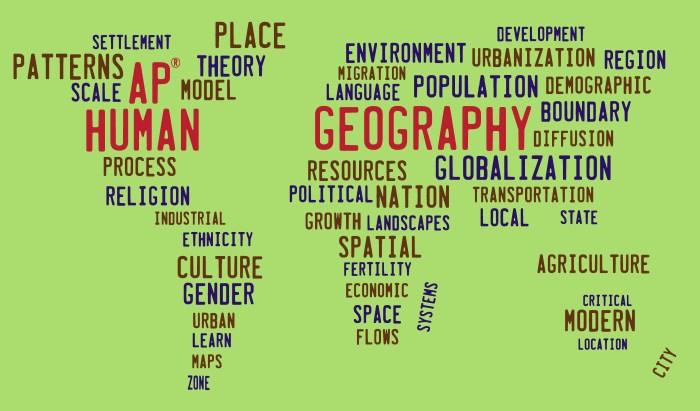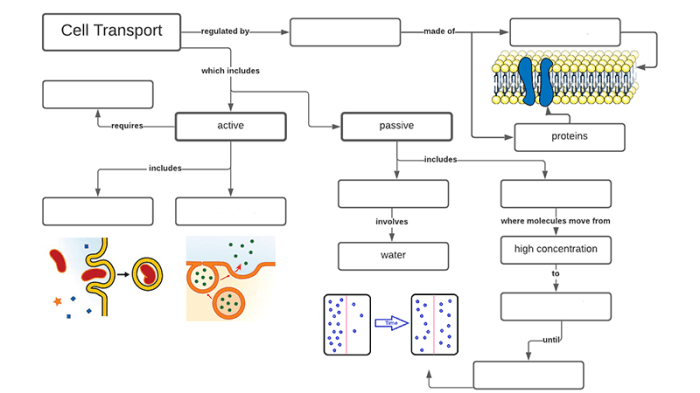The AP Human Geography Review Packet provides an invaluable resource for students preparing for the AP Human Geography exam. This comprehensive packet covers all the essential concepts, theories, and case studies necessary for exam success.
Through engaging explanations, detailed examples, and practice questions, this packet helps students develop a deep understanding of the subject matter and prepare effectively for the exam.
Concepts and Theories

Human geography explores the interactions between humans and their environment, examining how people shape and are shaped by the places they inhabit. Fundamental concepts include space, place, scale, and time, which provide frameworks for understanding human-environment relationships. Geographers utilize theories and models, such as the central place theory and the gravity model, to analyze spatial patterns and processes.
Scale
- Scale refers to the level of detail or generalization in a geographic analysis.
- Local scale: Focuses on small areas, such as a neighborhood or city.
- Regional scale: Examines larger areas, such as a state or country.
- Global scale: Considers the entire Earth or major world regions.
Population Geography
Population geography investigates the distribution, growth, and change of human populations. Factors influencing population distribution include physical geography, economic opportunities, and cultural preferences. Geographers analyze spatial patterns of population density and migration to understand population dynamics.
Demographic Transition Model
The demographic transition model describes the stages of population growth and change over time. It predicts a shift from high birth and death rates to low birth and death rates as societies modernize and develop.
Cultural Geography
Cultural geography explores the diverse cultures of the world and their influence on human landscapes and interactions. Elements of culture include language, religion, ethnicity, and customs. Geographers analyze how culture shapes the built environment, economic activities, and social relationships.
Cultural Diffusion
Cultural diffusion is the spread of cultural traits from one place to another. It can occur through migration, trade, or other forms of contact.
Economic Geography
Economic geography examines the spatial distribution of economic activities and their impact on human geography. Major economic activities include agriculture, manufacturing, and services. Geographers analyze factors that influence the location of industries and businesses, such as access to resources, transportation, and labor.
Globalization
Globalization refers to the increasing interconnectedness of the world’s economies and cultures. It has led to the emergence of global markets and the movement of goods, services, and people across borders.
Political Geography
Political geography examines the spatial organization of political systems and their influence on human geography. Types of political systems include democracies, autocracies, and federal states. Geographers analyze factors that shape political boundaries and territorial disputes.
Geopolitics, Ap human geography review packet
Geopolitics refers to the influence of geography on international relations and conflict. It considers factors such as access to resources, strategic location, and military power.
Environmental Geography
Environmental geography investigates the interactions between humans and the natural environment. It examines the impact of human activities on the environment, such as pollution, climate change, and deforestation. Geographers analyze environmental issues and promote sustainability.
Climate Change
Climate change refers to long-term changes in global temperatures and weather patterns. It is primarily caused by human activities that release greenhouse gases into the atmosphere.
Urban Geography
Urban geography explores the characteristics and functions of cities. It examines the processes of urbanization and suburbanization, as well as the challenges and opportunities of urban living.
Urbanization
Urbanization refers to the increasing proportion of the population living in urban areas. It is driven by factors such as economic opportunities, migration, and technological advancements.
Regional Geography
Regional geography examines the unique characteristics and development of major world regions. It considers factors such as physical geography, history, culture, and economic development.
Regional Cooperation
Regional cooperation refers to the collaboration between countries within a region to address common challenges and promote economic and political integration.
Spatial Analysis Techniques

Spatial analysis techniques are used to analyze spatial data and solve real-world problems. Common techniques include GIS (geographic information systems) and remote sensing. Geographers use these techniques to visualize and interpret spatial patterns and relationships.
GIS
GIS is a computer system that allows users to create, manage, and analyze spatial data. It is used in various fields, including urban planning, environmental management, and public health.
Contemporary Issues in Human Geography
Human geography continues to address emerging issues and challenges. These include climate change, inequality, migration, and globalization. Geographers play a vital role in understanding these issues and developing solutions.
Migration
Migration refers to the movement of people from one place to another. It can be driven by factors such as economic opportunities, political instability, or environmental disasters.
Answers to Common Questions: Ap Human Geography Review Packet
What topics are covered in the AP Human Geography Review Packet?
The packet covers all the topics Artikeld by the College Board for the AP Human Geography exam, including concepts and theories, population geography, cultural geography, economic geography, political geography, environmental geography, urban geography, regional geography, spatial analysis techniques, and contemporary issues in human geography.
How can I use the AP Human Geography Review Packet effectively?
To use the packet effectively, students should review the material thoroughly, complete the practice questions, and seek clarification on any concepts they find challenging. Regular use of the packet will help students build a strong foundation in human geography and prepare confidently for the exam.
Is the AP Human Geography Review Packet available online?
Yes, the AP Human Geography Review Packet is available for purchase and download from various online retailers, including Amazon and Barnes & Noble.



